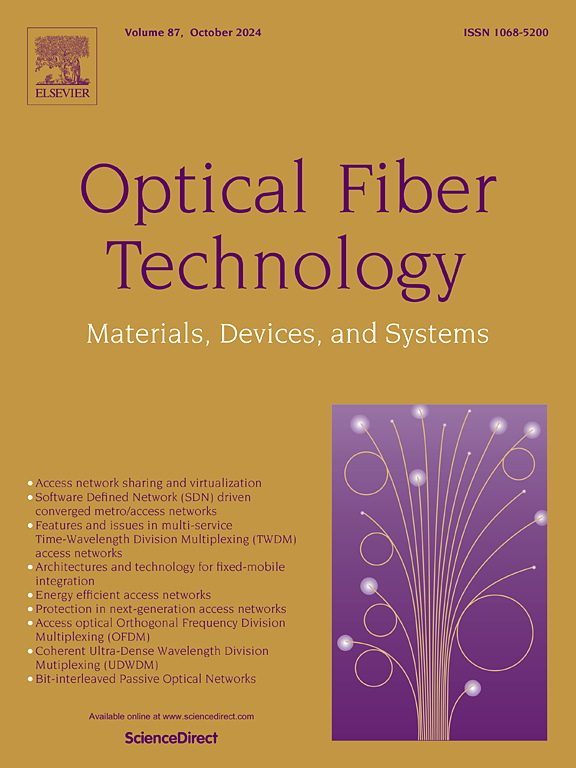评价EDFA响应建模对光网络QoT估计的影响
IF 2.6
3区 计算机科学
Q2 ENGINEERING, ELECTRICAL & ELECTRONIC
引用次数: 0
摘要
估计光网络的传输质量(QoT)是规划、管理和优化网络的关键指标。QoT估计依赖于光链路内部组件的良好建模,以准确地模拟传输和随之而来的信号退化。放大器是噪声和信号失真的来源;因此,放大器建模在QoT估计中起着至关重要的作用。我们评估了不同放大器模型对光网络中QoT估计的影响。我们的仿真基于GNPy,这是一个广泛用于光网络仿真和优化设计的QoT估计器。我们的主要贡献有:(1)一个新版本的GNPY,其中放大器可以使用功率掩模建模;(2)考虑先进GNPy放大器模型和功率掩模作为估计器的基准,考虑数值模拟器和实际放大器数据;(3)分析了各放大器型号对网络QoT的影响。结果表明,在单链路情况下,功率掩模模型相对于基准的最大误差为2.85 dB,而先进模型相对于基准的最大误差为4.61 dB。在网络场景中,结果表明,即使在高倾斜情况下,高级模型也倾向于提供更乐观和平坦的估计,而功率掩模模型在这些情况下对传输噪声更敏感,估计较低的GSNR和传输速率,包括几种连接阻塞情况。本研究的发现可能对希望通过模拟和软件控制网络实现更灵活的网络管理和优化的光网络研究人员和运营商有用。本文章由计算机程序翻译,如有差异,请以英文原文为准。
Evaluating the impact of EDFA response modeling in the optical network QoT estimation
Estimating the quality of transmission (QoT) in optical networks is a key metric for planning, managing, and optimizing networks. QoT estimation depends on good modeling of the internal components of the optical link to accurately simulate transmission and consequent signal degradation. The amplifier is a source of noise and signal distortion; therefore, amplifier modeling plays a crucial role in QoT estimation. We present an evaluation of the impact of different amplifier models on the estimation of QoT in optical networks. We based our simulation on GNPy, a QoT estimator widely used to simulate and optimize the design of optical networks. Our main contributions are: (1) a new version of the GNPY in which the amplifier can be modeled using a power mask; (2) a benchmark considering the advanced GNPy amplifier model and power mask as estimators considering a numeric simulator and real-world amplifier data; and (3) an analysis of the impacts in the network QoT for each amplifier model. The results show that, considering a single link scenario, the absolute maximum error of the Power Mask Model is 2.85 dB in relation to the benchmark, whereas the Advanced Model presented a maximum error of 4.61 dB. In the network scenario, the result shows that the Advanced Model tends to deliver more optimistic and flat estimates even in cases of high tilt, whereas the Power Mask Model is more sensitive to transmission noise in these cases, estimating lower GSNR and transmission rates, including several cases of connection blocking. The findings of this study may be useful to optical network researchers and operators who want to have more flexible network management and optimization through simulations and software-controlled networks.
求助全文
通过发布文献求助,成功后即可免费获取论文全文。
去求助
来源期刊

Optical Fiber Technology
工程技术-电信学
CiteScore
4.80
自引率
11.10%
发文量
327
审稿时长
63 days
期刊介绍:
Innovations in optical fiber technology are revolutionizing world communications. Newly developed fiber amplifiers allow for direct transmission of high-speed signals over transcontinental distances without the need for electronic regeneration. Optical fibers find new applications in data processing. The impact of fiber materials, devices, and systems on communications in the coming decades will create an abundance of primary literature and the need for up-to-date reviews.
Optical Fiber Technology: Materials, Devices, and Systems is a new cutting-edge journal designed to fill a need in this rapidly evolving field for speedy publication of regular length papers. Both theoretical and experimental papers on fiber materials, devices, and system performance evaluation and measurements are eligible, with emphasis on practical applications.
 求助内容:
求助内容: 应助结果提醒方式:
应助结果提醒方式:


